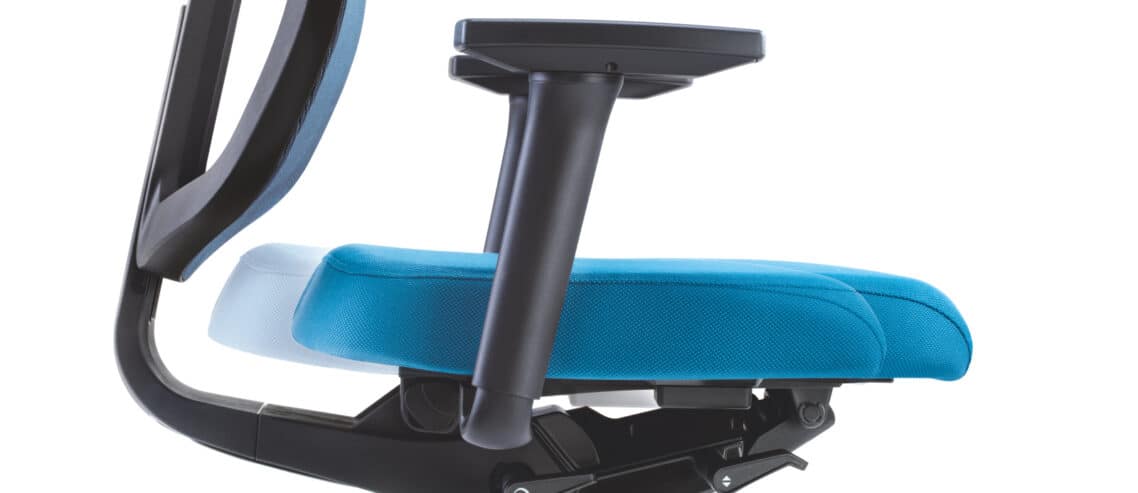How to Set Up an Ergonomic Chair: A Comprehensive Guide
Are you wondering how to set up an ergonomic chair so you can maximize comfort and prevent aches and pains? Here are some helpful tips to properly set up your ergonomic office chair.
Seat height
One of the essential features of an ergonomic office chair is its capacity to adjust to your body. First, you should adjust the chair height with the appropriate lever or knob. (It’s usually on the lower side of your chair.) The goal is to sit with your feet flat on the floor and your knees bent at a right angle. If you can’t adjust the seat height or your chair has a fixed height, you can also use a footrest.
Seat depth
Your office chair may have an adjustable seat depth. If so, adjust it to your body’s dimensions — particularly the length of your thighs. To adjust your chair correctly for proper seat depth, start in a sitting position. Place your back flat against the backrest. Adjust the seat so there’s at least an inch between the front edge of the seat and the back of your bent knees. Ideally, you should have enough space to fit a clenched fist in between your knees and the chair. This stops the chair seat from restricting circulation to your lower legs.
Backrest
The back of your ergonomic chair is one of the most important elements that affect your sitting posture. Adjust the backrest recline and tension to provide support, allowing you to move freely. Experts at Cornell University’s ergonomics department recommend keeping your chair reclined at about 110 degrees.1 But you might be able to unlock the recline position and lean further back intermittently. This shift in positions can help promote circulation and redistribute pressure.
You may also be able to adjust the tension on your chair. If so, adjust the tension so you can lean back without using excessive force or losing your balance. Make sure the chair doesn’t spring upright too strongly when you lean forward.
Lumbar support
Some chairs will have a backrest adjustment that raises or lowers the position of the lumbar support. If so, adjust the backrest’s lumbar support, so it cradles the natural curvature of your lower back. If your chair has lumbar depth, adjust accordingly to your liking. Use a rolled-up towel to provide proper support if your chair does not have this feature.
Armrests
Not every chair will have armrests. In fact, ergonomic chairs don’t need to have them. The best position for your arms is resting with your elbows at 90 degrees (or slightly wider) on your work surface. However, armrests are excellent when you’re experiencing discomfort or need to take a deep breath and shift positions. Naturally, your armrests should always be at the same height. They should sit at about elbow height when your arms are vertically against your sides. If your armrests can pivot, move these until they fit your liking.
Headrest
Not all chairs have headrests. With an adjustable chair and excellent posture, you should comfortably be able to hold your head in a neutral position. However, for chairs with a headrest, adjust it to the base of the back of your head. Your head should not feel like it’s being pushed forward or downward. Headrests are helpful when you slightly adjust your office chair sitting position throughout the day. They’re also beneficial if you stretch out your lower or upper back by leaning back in your chair.
Now that you know how to set up an ergonomic chair, set up your whole workstation
With all this knowledge, you’re equipped to jump right into the workday with a comfortably adjusted and contoured chair. Don’t forget to make other adjustments to your workstation that encourage healthy movement throughout the day. This may include looking into office desks with adjustable desk height features. It may also mean trying alternative seating, like an ergonomic stool or ball.
Whatever you choose, make sure it’s adjusted to the right height. You should also sit at arm’s length from your monitor to prevent eye strain. And remember, even with the perfect chair, poor posture renders helpful features useless. Stay conscious of how you’re engaging with your ergonomic furniture. Then, you’ll be prepared for a productive workday and healthy lifestyle.
When looking for the right office chair, consider the stylish options offered at Sedus. Whatever furniture you need to craft the perfect ergonomic workstation, Sedus has the solution. Contact one of their consultants to learn how to style and revamp your workplace.
1 Ergonomic Guidelines for arranging a Computer Workstation – 10 steps for users
